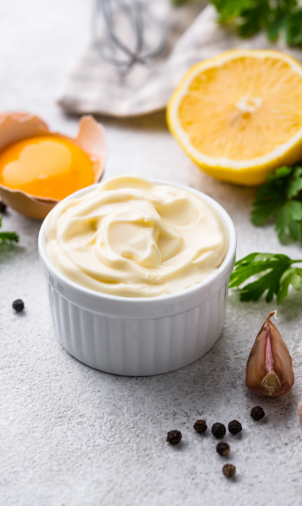
Is Mayo Healthy? Understanding Its Benefits, Risks, and Healthier Alternatives
Mayonnaise is a beloved condiment, known for its rich, creamy texture that enhances everything from sandwiches and salads to sauces and dressings. While mayo is often enjoyed for its flavor, many wonder: is mayonnaise healthy?
In this article, we’ll break down the nutritional content of mayonnaise, explore its health benefits and potential drawbacks, and look at healthier alternatives that allow you to enjoy mayo without compromising your health goals.
What Is Mayonnaise Made Of?
Traditional mayonnaise is made from just a few simple ingredients: eggs, oil, and vinegar or lemon juice. The eggs act as an emulsifier, allowing the oil and vinegar to blend smoothly into a creamy texture. The oil used is typically soybean or canola oil, both of which are inexpensive and neutral in flavor. The vinegar or lemon juice adds acidity to balance the richness of the oil.
However, in many commercial varieties, additional preservatives, stabilizers, and sugars are added to improve flavor and shelf life. These additives can affect the overall nutritional profile of mayonnaise, particularly by adding unhealthy fats and sugars.
Healthier Mayo Variations
As people increasingly seek healthier options, there are now several variations of traditional mayonnaise available:
-
Avocado Oil Mayo: Made with heart-healthy avocado oil, this version provides monounsaturated fats, which are good for the heart.
-
Olive Oil Mayo: Made with extra virgin olive oil, offering added antioxidants and healthier fats.
-
Vegan Mayo: For those avoiding animal products, vegan mayo uses plant-based emulsifiers like soy protein or aquafaba (chickpea brine), often mixed with oils like sunflower or avocado.
These variations cater to a range of dietary preferences while maintaining the creamy texture that makes mayo so popular.
Mayo Nutrition Facts
Mayonnaise is a calorie-dense condiment, with each tablespoon containing about 90–100 calories. Most of these calories come from fat, making mayo an energy-rich option, but also one to consume in moderation.
Here’s a breakdown of the key nutritional components in one tablespoon (about 15g) of regular mayonnaise:
-
Calories: 90–100
-
Fat: 10g
-
Saturated Fat: 1–2g
-
Omega-6 Fatty Acids: Present in higher amounts, particularly in soybean or corn oil
-
-
Cholesterol: 5mg
-
Sodium: 80–100mg
-
Vitamins:
-
Vitamin E: Antioxidant that supports skin and eye health
-
Vitamin K: Important for bone health and blood clotting
-
Comparison Table: Regular, Low-Fat, and Avocado Oil Mayo
| Type | Calories | Total Fat (g) | Saturated Fat (g) | Cholesterol (mg) | Sodium (mg) | Vitamin E (mg) | Vitamin K (mcg) |
|---|---|---|---|---|---|---|---|
| Regular Mayo | 90–100 | 10 | 1–2 | 5 | 80–100 | 0.1–0.2 | 0–5 |
| Low-Fat Mayo | 35–50 | 2–5 | 0.5–1 | 0 | 80–90 | 0.1 | 0–5 |
| Avocado Oil Mayo | 100–120 | 10–12 | 1–1.5 | 5 | 80–90 | 1.0 | 5–7 |
Is Mayo Healthy or Unhealthy?
Mayonnaise often gets a bad reputation due to its high-calorie and fat content. However, whether mayo is healthy or not largely depends on the type of mayo and how much you consume.
Pros of Mayo in Moderation
-
Healthy Fats: If made with high-quality oils like olive oil or avocado oil, mayo provides healthy fats that are beneficial for heart health and inflammation control. These oils contain monounsaturated fats, which help improve cholesterol levels and reduce the risk of cardiovascular disease.
-
Fat-Soluble Vitamins: Mayo is an excellent source of fat-soluble vitamins like Vitamin E and Vitamin K. These vitamins are best absorbed with fat, and mayo helps deliver them efficiently to the body.
-
Keto-Friendly: Mayonnaise is low in carbohydrates, making it a suitable addition to low-carb or keto diets. It provides high-fat content without adding significant carbs, perfect for those following a keto eating plan.
Health Concerns of Mayo
-
High in Calories and Fats: One tablespoon of mayo can quickly add 90–100 calories to your meal. If used excessively, mayo can contribute to weight gain and an imbalance of fats in your diet. Portion control is essential to ensure mayo doesn’t negatively affect your health goals.
-
Imbalanced Omega-6 to Omega-3 Ratio: Many traditional mayonnaise recipes use oils high in omega-6 fatty acids (like soybean or corn oil). While omega-6s are essential, an excess of omega-6s relative to omega-3s can promote inflammation, which is linked to chronic diseases. It’s crucial to balance omega-6 intake with omega-3-rich foods (like fish or flaxseeds).
-
Added Sugar and Preservatives: Some commercial mayos contain added sugars and preservatives to enhance flavor and shelf life. These additives can diminish the health benefits of mayo, making it less nutritious.
Healthier Mayo Alternatives
If you’re looking for a healthier mayo option, several alternatives provide similar texture and taste with added nutritional benefits:
-
Homemade Mayo with Olive Oil or Avocado Oil: Making your own mayo at home allows you to control the ingredients and use healthier oils like olive oil or avocado oil. These oils offer heart-healthy monounsaturated fats and essential nutrients like Vitamin E.
-
Greek Yogurt-Based Mayo: Greek yogurt is a great low-fat and high-protein substitute for mayo. It’s also packed with probiotics that support gut health, and when combined with olive oil, it creates a creamy, tangy spread that’s much lighter than regular mayo.
-
Hummus or Mashed Avocado: Hummus and mashed avocado are excellent creamy substitutes for mayo. Hummus is made from chickpeas and tahini, offering fiber, protein, and healthy fats. Mashed avocado is rich in monounsaturated fats and vitamins like Vitamin E and C.
-
Vegan Mayo: For plant-based diets, vegan mayo made from ingredients like aquafaba (chickpea brine) or tofu offers a great alternative without the use of eggs. It’s typically made with healthy oils like sunflower or avocado oil, but be sure to check for added sugars.
How to Include Mayo in a Healthy Diet
Mayonnaise can be part of a healthy diet if used in moderation. Here are some tips for incorporating mayo without going overboard:
-
Portion Control: Since mayo is calorie-dense, use it sparingly. A small amount can add flavor without adding excess calories. Consider mixing it with healthier ingredients like Greek yogurt or avocado to reduce the amount used while adding extra nutrition.
-
Pair with Nutritious Ingredients: Mayo can be used to enhance nutrient-dense meals. For example, mix it into salads with leafy greens and lean proteins like chicken or tuna. This creates a balanced meal that’s flavorful and full of essential nutrients.
-
Mayo-Based Dips and Dressings: Mix mayo with fresh herbs and spices to create flavorful dips or dressings. For example, a light ranch dressing made with mayo, lemon juice, and herbs can enhance the flavor of your salads or serve as a healthy dip for veggies.
Conclusion – Is Mayo Healthy?
The answer to whether mayo is healthy depends on how it’s made and how much you consume. Traditional mayo is calorie-dense and high in fat, so it should be consumed in moderation. However, when made with healthier oils like olive or avocado oil, mayo can offer heart-healthy fats and essential vitamins.
For those seeking lighter options, consider homemade mayo or Greek yogurt-based spreads. If you’re following specific diets like keto or vegan, there are plenty of alternatives that cater to your needs. By practicing portion control and choosing healthier variations, you can enjoy mayo without compromising your health goals.




